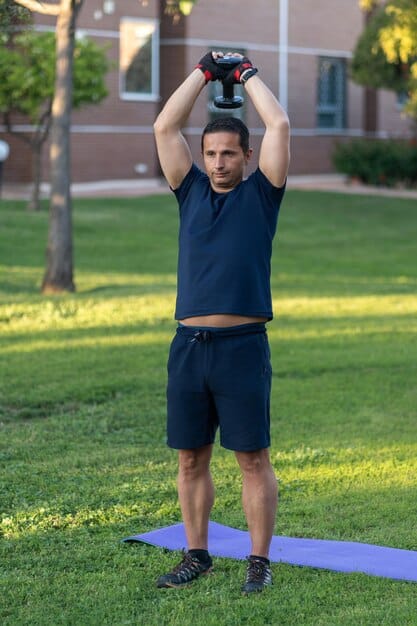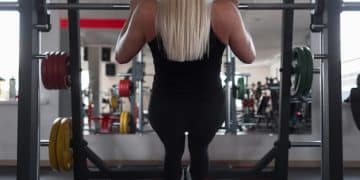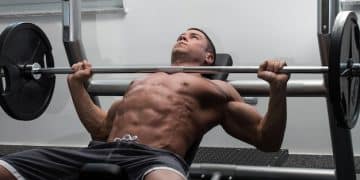Master Shoulder Prehab: Prevent Injuries, Get Stronger

Achieving resilient, injury-free shoulders requires a dedicated prehabilitation routine focused on stability, mobility, and strength, proactively mitigating common risks associated with intense training and daily life.
Are you striving for formidable strength and improved performance, but wary of the pervasive shadow of shoulder injuries? Delving into a comprehensive Get Stronger Shoulders: The Prehab Routine to Prevent Injuries is not merely an option, but a foundational requirement for sustainable athletic pursuits and everyday well-being.
The critical role of shoulder health in overall fitness
The shoulder joint, anatomically known as the glenohumeral joint, is a marvel of human engineering, offering the greatest range of motion of any joint in the body. This incredible mobility, however, comes at a cost: inherent instability. Unlike the deeply socketed hip, the shoulder relies heavily on a complex interplay of muscles, tendons, and ligaments—collectively known as the rotator cuff and surrounding musculature—to maintain stability. When this intricate system is compromised, due to weakness, imbalance, or overuse, the risk of injury skyrockets, impacting not just your lifting goals but also fundamental daily activities.
Understanding the shoulder’s vulnerability is the first step towards safeguarding it. Many conventional strength training programs, while effective for building mass and power, often neglect the smaller, stabilizing muscles crucial for shoulder integrity. This oversight can lead to muscular imbalances, where larger, prime mover muscles (like the deltoids or pectorals) overpower the weaker stabilizing muscles, pulling the joint out of optimal alignment. Over time, this imbalance can cause wear and tear, inflammation (tendinitis or bursitis), impingement, or even acute tears, especially in the rotator cuff.
Common shoulder injury mechanisms
Shoulder injuries are unfortunately pervasive in fitness communities, affecting athletes and casual exercisers alike. Recognizing the catalysts behind these injuries is paramount for effective prevention.
- Overuse and repetitive strain: Many exercises, like overhead presses or bench presses, if performed with improper form or excessive volume, can repeatedly stress the shoulder joint, leading to cumulative micro-trauma.
- Poor posture and biomechanics: Slouched shoulders, forward head posture, or rounded upper backs can significantly alter shoulder mechanics, placing undue stress on the rotator cuff and leading to impingement.
- Muscle imbalances: An overemphasis on pushing exercises (chest, triceps) without adequate attention to pulling exercises (back, biceps) can create strong anterior muscles and weak posterior muscles, pulling the shoulders forward and inward.
- Lack of mobility and stability: Stiff thoracic spines or tight chest muscles can restrict proper shoulder blade movement, forcing the glenohumeral joint to compensate. Similarly, weak rotator cuff muscles fail to adequately stabilize the humeral head within the joint.
Addressing these underlying issues through a dedicated prehabilitation routine is not about reactive treatment but proactive protection. It’s about building a robust, resilient shoulder complex that can withstand the demands of your training and daily life, ensuring longevity in your fitness journey without the debilitating setbacks of injury. By prioritizing the health and function of your shoulders, you unlock the potential for truly strong, pain-free performance.
Understanding prehabilitation: Proactive protection for your shoulders
Prehabilitation, often abbreviated as “prehab,” is a distinct and proactive approach to injury prevention that differentiates itself from rehabilitation. While rehabilitation focuses on recovery and returning to function after an injury has occurred, prehab aims to identify and address potential weaknesses, imbalances, or mobility deficits before an injury takes hold. For a complex and vulnerable joint like the shoulder, prehabilitation is not just beneficial; it’s essential for anyone engaged in physical activity, from professional athletes to weekend warriors.
The core philosophy of prehab is built on the premise that prevention is always superior to cure. By strengthening supporting musculature, improving joint mobility, and enhancing proprioception (your body’s awareness of its position in space), prehab routines create a resilient system less susceptible to the stresses of training and everyday movements. For the shoulders, this means consciously targeting the smaller, often overlooked muscles of the rotator cuff, the scapular stabilizers, and the surrounding musculature that dictates optimal shoulder girdle mechanics.
Unlike general warm-ups, which prepare the body for immediate activity, a prehab routine is a more structured and consistent practice. It’s an investment in long-term joint health and performance. This isn’t about simply stretching or doing a few light reps; it involves targeted exercises designed to correct specific dysfunctions and reinforce proper movement patterns. It’s about systematically building a robust foundation that can safely absorb the impact and forces generated during demanding exercises like overhead presses, pull-ups, or throwing motions.
Key components of an effective shoulder prehab program
A well-rounded shoulder prehab program integrates several crucial elements, each playing a vital role in fortifying shoulder health. These components work synergistically to create a shoulder complex that is not only strong but also mobile, stable, and capable of efficient movement.
- Rotator cuff strengthening: The four muscles of the rotator cuff (supraspinatus, infraspinatus, teres minor, subscapularis) are pivotal for stabilizing the humeral head within the glenoid fossa. Specific internal and external rotation exercises, often performed with light weights or resistance bands, are fundamental.
- Scapular stability: The shoulder blade (scapula) serves as the foundation for arm movement. Muscles like the serratus anterior, rhomboids, and trapezius must be strong and coordinated to ensure the scapula moves correctly. Exercises such as face pulls, scapular push-ups, and Y-raises help reinforce proper scapular positioning.
- Thoracic spine mobility: A stiff upper back (thoracic spine) can severely limit overhead arm movement, forcing the shoulders to compensate and increasing injury risk. Thoracic rotation exercises, foam rolling, and cat-cow stretches improve spinal mobility, allowing the shoulders to move through their full, natural range of motion.
- Mobility and flexibility: Targeted stretches for the chest, lats, and anterior deltoids can release tightness that pulls the shoulders forward, while dynamic movements improve overall joint range of motion.
- Proprioception and motor control: Exercises that challenge balance and coordination, often involving unstable surfaces or single-arm movements, enhance the nervous system’s ability to control joint position, further reducing injury susceptibility.

By consistently incorporating these elements into your training regimen, you transition from reactively treating injuries to proactively building a bulletproof upper body. Prehab is not an optional extra; it’s a non-negotiable insurance policy for sustainable strength, performance, and long-term shoulder health. It allows you to push your limits with confidence, knowing that your shoulders are well-prepared to handle the demands placed upon them, paving the way for consistent progress and preventing frustrating setbacks.
The foundational pillars of shoulder strength and stability
True shoulder strength and stability extend far beyond the impressive definition of your deltoids. It’s rooted in the coordinated function of a multitude of muscles, tendons, and ligaments that collectively work to secure the humerus within the glenoid cavity and control the scapula’s movement. Building robust shoulders requires a focus on these underlying mechanisms, addressing imbalances, and fortifying the often-overlooked supporting cast of muscles.
At the heart of shoulder health lies the intricate relationship between the rotator cuff and the scapular stabilizers. The rotator cuff muscles—supraspinatus, infraspinatus, teres minor, and subscapularis—are not primarily about moving heavy weight. Their essential role is to dynamically stabilize the humeral head centrally within the shoulder socket throughout the entire range of motion, preventing excessive translation or impingement. When these muscles are weak or not properly engaged, the larger, more powerful muscles can pull the arm out of alignment, leading to friction and damage.
Equally vital are the scapular stabilizers: the rhomboids, middle and lower trapezius, and serratus anterior. The scapula (shoulder blade) acts as the foundation upon which your arm moves. If the scapula isn’t stable or doesn’t move correctly (e.g., winging, excessive downward rotation), the glenohumeral joint is forced to compensate, leading to impingement or overuse injuries. For instance, weak serratus anterior muscles can prevent proper upward rotation of the scapula during overhead movements, jamming the rotator cuff tendons against the acromion.
Furthermore, mobility of the thoracic spine (upper back) plays a surprisingly significant role. If your thoracic spine is stiff, you’ll struggle to achieve full overhead arm extension without compensating through your lower back or forcing your shoulders into unhealthy positions. This can lead to rounded shoulders and an anterior pelvic tilt, further contributing to poor shoulder mechanics. A mobile thoracic spine allows the scapula to move unimpeded, facilitating a healthier range of motion and reducing stress on the shoulder joint itself.
Beyond isolated muscle strength, the nervous system’s ability to coordinate these different muscle groups is paramount. Proprioception—your body’s ability to sense its position and movement—is key. Exercises that challenge balance and control in different planes of motion enhance this neurological connection, ensuring that muscles fire efficiently and at the right time to protect the joint.
Therefore, cultivating strong, resilient shoulders involves a holistic strategy that focuses on:
- Rotator cuff integrity: Ensuring these vital stabilizers are strong and active.
- Scapular control: Teaching the shoulder blades to move correctly with the arm.
- Thoracic mobility: Freeing up the upper back to support overhead movements.
- Balanced strength: Addressing muscle imbalances between pushing and pulling muscles, as well as internal and external rotators.
- Neuromuscular coordination: Enhancing the brain-muscle connection for precise and protective movements.
Neglecting any of these pillars leaves the shoulder vulnerable. By systematically integrating exercises that target each of these areas, you lay a concrete foundation for a shoulder girdle that is not only capable of impressive feats of strength but also remarkably resistant to injury, allowing for sustained, high-level performance and long-term joint health.
Implementing your prehab routine: Exercises and best practices
Integrating a shoulder prehabilitation routine into your existing fitness regimen doesn’t have to be cumbersome. The key is consistency and proper execution. Aim to perform these exercises 2-3 times per week, either as part of your warm-up, on off-days, or as a dedicated session. The goal is quality over quantity, focusing on controlled movements and muscle activation rather than lifting heavy. Resistance bands are excellent tools for many of these exercises, providing continuous tension without taxing the joints excessively.
Before diving into the exercises, remember that proper form is paramount. Light weights or resistance bands are often sufficient, allowing you to focus on the targeted muscles. Avoid swinging or using momentum; each movement should be deliberate and controlled, emphasizing the eccentric (lowering) phase as much as the concentric (lifting) phase. Listen to your body: if an exercise causes pain, stop immediately and re-evaluate your form or consult a professional.
Essential prehab exercises for bulletproof shoulders
This selection of exercises targets the core pillars of shoulder strength and stability, addressing rotator cuff function, scapular control, and overall mobility. Start with 2-3 sets of 10-15 repetitions for each exercise, gradually increasing reps or resistance as your strength and control improve.
- Band pull-aparts: Stand with feet shoulder-width apart, holding a resistance band with an overhand grip, hands about shoulder-width apart, arms extended straight out in front of you at shoulder height. Keeping arms straight, pull the band apart by retracting your shoulder blades, squeezing them together. Imagine touching your shoulder blades together. Slowly return to the start.
- Face pulls: Attach a rope handle to a cable machine at chest height. Step back to create tension. Pull the rope towards your face, leading with your elbows and externally rotating your shoulders. Focus on squeezing your shoulder blades together and externally rotating your shoulders at the end of the movement.
- Internal and external rotations (with band or light dumbbell): For external rotations, stand holding a resistance band looped around a stable object, or a light dumbbell. Keep your elbow tucked at your side, forming a 90-degree angle. Rotate your forearm outwards, away from your body. For internal rotations, perform the opposite motion, rotating your forearm inwards across your body.
- Scapular push-ups (plus planks): Assume a push-up position, but instead of bending your elbows, simply allow your shoulder blades to retract (let your chest sink slightly between your shoulders) and then protract (push your upper back towards the ceiling, rounding it slightly) without bending your arms. This exercise isolates scapular movement. Incorporate planks to strengthen core stability, which directly supports shoulder girdle integrity.
- YTWLs (prone): Lie face down on a bench or the floor. Extend your arms to form a ‘Y’, ‘T’, ‘W’, and ‘L’ shape, lifting them slightly off the ground by engaging your upper back and shoulder blades. Focus on controlled movements, keeping your neck neutral and your core engaged.
Beyond these specific movements, consider incorporating foam rolling for your thoracic spine and lats to improve mobility, and gentle stretching for your chest and anterior deltoids to counteract tightness. Remember, consistency is the bedrock of prehab. Making these exercises a regular part of your training will compound benefits over time, building a resilient, pain-free foundation for all your physical endeavors. It’s a small investment with significant returns in terms of long-term joint health and athletic performance.
Advanced strategies for optimizing shoulder resilience
Once you’ve established a consistent foundational prehab routine, you can further optimize your shoulder resilience by incorporating more advanced strategies. These techniques delve deeper into movement quality, progressive overload, and integrated full-body mechanics, ensuring your shoulders are not just strong in isolation but function optimally within complex, high-demand movements. The goal is to evolve your prehab from a “fix-it” routine to an integral part of your performance training.
One critical advanced strategy is focusing on the eccentric phase of movements. The eccentric (lowering) portion of an exercise puts muscles under tension as they lengthen, which is incredibly effective for building strength and improving tendon resilience. For shoulder prehab, this means deliberately slowing down the lowering phase of exercises like overhead presses (with light weights), pull-ups, or even external rotations. Control the movement through its entire range, embracing the challenge of the negative. This enhances tissue tolerance and can significantly reduce the risk of injury from sudden impacts or uncontrolled movements.
Another powerful tactic is the integration of compound movements that challenge shoulder stability in dynamic, multi-joint contexts. While isolation exercises are crucial for targeting specific muscles, real-world movements and athletic endeavors rarely involve isolated joint actions. Incorporating exercises like Turkish get-ups, overhead carries, or kettlebell presses not only trains the shoulders but also demands coordinated input from the core, hips, and legs. This holistic approach builds robust stabilization patterns that translate directly to improved performance and injury prevention in more complex lifts and activities.
Progressive overload and strategic deloads
Just like with strength training, prehab can benefit from progressive overload, albeit with different metrics. Instead of simply piling on weight, progressive overload in prehab focuses on increasing repetitions, sets, duration of holds, or complexity of movements. For instance, progressing from two-arm band pull-aparts to single-arm variations, or increasing the time you hold a YTWL position. This gradual increase in challenge continually adapts your tissues and neurological pathways, making your shoulders more robust.
Equally important is the strategic use of deloads. Even with prehab, repetitive stress can accumulate. Incorporating periods of reduced volume or intensity, or entirely shifting your prehab exercises, allows your tissues to recover and adapt without constant undue stress. This cyclical approach prevents burnout and ensures long-term progress.
- Unilateral training: Incorporating single-arm exercises (e.g., single-arm overhead press, single-arm rows, single-arm face pull) challenges each shoulder independently, exposing and correcting imbalances that bilateral movements might mask.
- Variable resistance: Utilizing resistance bands with different tensions or combining free weights with bands challenges muscles across the entire range of motion, from peak contraction to the deepest stretch.
- Proprioceptive drills: Progressing from stable surfaces to unstable ones (e.g., balance boards, bosu balls) or incorporating movements that subtly shift your center of gravity enhances your body’s unconscious ability to stabilize the shoulder joint.
- Movement pattern refinement: Regularly filming yourself performing key exercises (e.g., overhead press, bench press) and analyzing your form, looking for any compensation patterns or subtle instability that might indicate underlying shoulder issues.

Finally, remember that recovery is as crucial as the training itself. Adequate sleep, proper nutrition, and stress management all contribute to your body’s ability to repair and adapt, reinforcing the gains made in your prehab routine. By consistently implementing these advanced strategies, you’re not just preventing injuries; you’re building a foundation of elite-level shoulder resilience that will serve you well in all your physical pursuits, ensuring sustained performance and a lifetime of pain-free movement.
Nutrition and recovery: Fueling your shoulder health
While targeted exercises form the cornerstone of a prehabilitation routine, the effectiveness of your efforts is significantly amplified by a holistic approach to nutrition and recovery. Think of your body, particularly your joints and tendons, as an intricate machine that requires not just proper maintenance (prehab exercises) but also high-quality fuel and adequate downtime for repair and regeneration. Neglecting these crucial elements can undermine even the most diligently performed prehab routine, leaving your shoulders vulnerable despite your best intentions.
Nutrition provides the building blocks for tissue repair, inflammation control, and overall joint lubrication. Adequate protein intake is paramount, as connective tissues like tendons and ligaments are primarily composed of collagen, which is synthesized from amino acids. Aim for a consistent intake of high-quality protein sources throughout the day to support tissue turnover and repair, especially after strenuous activity. Equally important are essential fatty acids, particularly Omega-3s, found in fatty fish, flaxseeds, and walnuts. These powerful anti-inflammatory agents can help mitigate the low-grade inflammation that often accompanies repetitive movements and training, fostering a healthier joint environment.
Beyond macronutrients, a vibrant array of micronutrients plays a crucial role. Vitamin C is essential for collagen synthesis, making it vital for tendon and ligament health. Calcium and Vitamin D contribute to bone density, which forms the structural anchor for your shoulder joint. Antioxidants, abundant in fruits and vegetables, combat oxidative stress, further protecting your tissues from damage. Ensuring a diet rich in diverse, whole foods provides the comprehensive nutritional support your shoulders need to remain resilient and recover efficiently.
The critical role of recovery practices
Recovery is where the actual strengthening and repair happen. Training provides the stimulus for adaptation, but it’s during rest that your body rebuilds tissues, recharges energy stores, and solidifies neurological pathways. Without sufficient recovery, chronic fatigue can set in, leading to decreased performance, impaired coordination, and increased susceptibility to injury.
- Sleep: This is arguably the most potent recovery tool. During deep sleep, your body releases growth hormone, critical for tissue repair and regeneration. Aim for 7-9 hours of quality sleep per night. Poor sleep impairs muscle recovery and can heighten perceived pain, making minor aches feel worse.
- Active recovery: Light activities like walking, gentle cycling, or swimming can promote blood flow, help flush out metabolic waste, and reduce muscle soreness without adding significant stress. This is particularly beneficial on off-days or after intense workouts.
- Stress management: Chronic stress elevates cortisol levels, which can have catabolic effects on muscle tissue and hinder recovery. Incorporate stress-reducing practices like mindfulness, meditation, deep breathing, or hobbies to keep cortisol in check.
- Hydration: Water is fundamental for joint lubrication, nutrient transport, and waste removal. Dehydration can impair tissue elasticity and overall function. Maintain consistent hydration throughout the day.
Ignoring nutrition and recovery is like trying to build a skyscraper with insufficient materials and no time for the cement to cure. Your prehab routine will only be as strong as the foundation you provide through appropriate fueling and thoughtful rest. By prioritizing these elements alongside your physical exercises, you create an optimal internal environment, ensuring your shoulders not only benefit from your prehab efforts but also thrive under the demands of your active life, remaining strong, functional, and injury-free for years to come.
Integrating prehab as a lifestyle: Beyond the gym
The true power of shoulder prehabilitation extends far beyond the confines of the gym. To truly safeguard your shoulders for the long haul, prehab must evolve from a set of exercises into a holistic lifestyle approach. This means being mindful of your shoulder health throughout your day, recognizing how daily habits, posture, and even seemingly innocuous activities can incrementally contribute to or detract from their resilience. It’s about cultivating a deeper awareness of your body’s mechanics and proactively making choices that support optimal joint function, whether you’re at your desk, driving, or engaging in leisure activities.
One of the most significant external factors impacting shoulder health outside of direct exercise is posture. Prolonged periods of sitting, especially with rounded shoulders, a forward head posture, or slouched upper back, can shorten chest muscles, stretch and weaken upper back muscles, and alter the natural mechanics of the shoulder girdle. This often leads to a phenomenon known as “upper crossed syndrome,” where certain muscles become tight and overactive while their antagonists become weak and inhibited. Consciously correcting your posture—shoulders back and down, chest open, head aligned over your spine—can significantly alleviate chronic stress on the shoulder joint and improve scapular positioning.
Ergonomics in your workspace also plays a vital role. If you spend hours at a computer, ensure your monitor is at eye level, your keyboard and mouse are positioned to keep your elbows at a 90-degree angle, and your forearms are supported. Taking frequent micro-breaks to stand, stretch, and perform simple shoulder rolls can prevent stiffness and promote blood flow. Similarly, when engaging in hobbies or household tasks that involve repetitive arm movements (e.g., gardening, painting, DIY projects), be mindful of your body mechanics and intersperse tasks with movement breaks or compensatory exercises.
Developing mindful movement habits
Integrating prehab into your lifestyle means developing mindful movement habits that become second nature. This doesn’t require constant rigid adherence but rather an increased awareness and occasional check-ins with your body. Simple practices can make a profound difference:
- Regular posture checks: Periodically assess your posture throughout the day, especially when sitting or standing for long periods. Gently reset your shoulders back and down, engaging your core slightly.
- Micro-movements: During breaks, perform quick, gentle shoulder rolls, neck stretches, or band pull-aparts to counteract stiffness and promote circulation.
- Balanced carrying: When carrying bags or heavy items, distribute the weight evenly or alternate arms to prevent one shoulder from being chronically overloaded.
- Awareness in daily tasks: Pay attention to your shoulder mechanics when reaching, lifting, or pushing. Use your legs and core more when lifting, and avoid shrugging your shoulders when performing overhead tasks.
- Stress and tension management: Many people hold stress in their neck and shoulders, leading to chronic tension. Incorporate relaxation techniques like deep breathing, meditation, or light stretching to release this tension.
By extending the principles of prehabilitation beyond your dedicated workout sessions and weaving them into the fabric of your daily life, you create a continuously supportive environment for your shoulders. This holistic approach fosters long-term joint health, reduces the cumulative impact of everyday stressors, and empowers you to maintain peak performance and pain-free living, ensuring that your strong, resilient shoulders remain a steadfast asset for years to come.
| Key Benefit | Brief Description |
|---|---|
| 🛡️ Injury Prevention | Proactively strengthens supporting muscles to guard against common shoulder injuries like impingement or rotator cuff tears. |
| 🚀 Enhanced Performance | Improves stability and range of motion, allowing for safer and more effective execution of overhead and pressing movements. |
| 🎯 Better Posture | Corrects muscle imbalances, pulling shoulders back and down, leading to improved posture and reduced chronic pain. |
| 🏃 Long-term Health | Ensures sustainable athletic pursuits and pain-free daily activities by maintaining robust joint integrity over time. |
Frequently asked questions about shoulder prehab
▼
Prehabilitation (prehab) is a proactive approach focused on preventing injuries by strengthening weak areas and improving mobility before issues arise. Rehabilitation (rehab), conversely, is a reactive process aimed at restoring function and reducing pain after an injury has already occurred. Prehab is about building resilience; rehab is about recovery.
▼
For most individuals, performing a shoulder prehab routine 2-3 times per week is ideal. It can be integrated into your warm-up before workouts, as a dedicated recovery session on off-days, or split into shorter mini-routines on various days. Consistency is more important than duration or intensity.
▼
No special equipment is strictly necessary; many exercises can be done with just bodyweight. However, light resistance bands are incredibly versatile and effective for targeting the small, stabilizing muscles of the rotator cuff and scapular stabilizers. Light dumbbells or kettlebells can also be beneficial as you progress.
▼
While prehab can significantly help manage and alleviate chronic shoulder pain by addressing underlying imbalances and weaknesses, it is not a substitute for professional medical advice. If you have persistent or acute shoulder pain, consult a doctor or physical therapist for a proper diagnosis and treatment plan before starting any new exercise routine.
▼
Results vary depending on individual starting points and consistency. Most people will begin to notice improvements in shoulder stability, reduced discomfort, and better movement quality within 4-6 weeks of consistent prehab. Long-term benefits, such as significant injury prevention, are cumulative and seen over months and years of dedicated practice.
Conclusion
Embracing a comprehensive shoulder prehabilitation routine is an indispensable investment in your long-term physical well-being and athletic prowess. It transcends mere exercise, becoming a philosophy of proactive self-care that safeguards one of the body’s most complex and vulnerable joints. By consistently integrating targeted strengthening, mobility work, and conscious movement habits, you not only fortify your shoulders against common injuries but also unlock greater potential for performance, both in structured workouts and the dynamic landscape of daily life. The commitment to building robust, resilient shoulders through diligent prehab is a commitment to a future free from nagging pain and debilitating setbacks, ensuring you can continue to pursue your fitness goals and enjoy a fulfilling, active existence.





